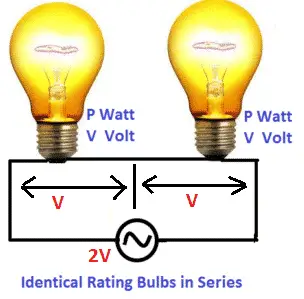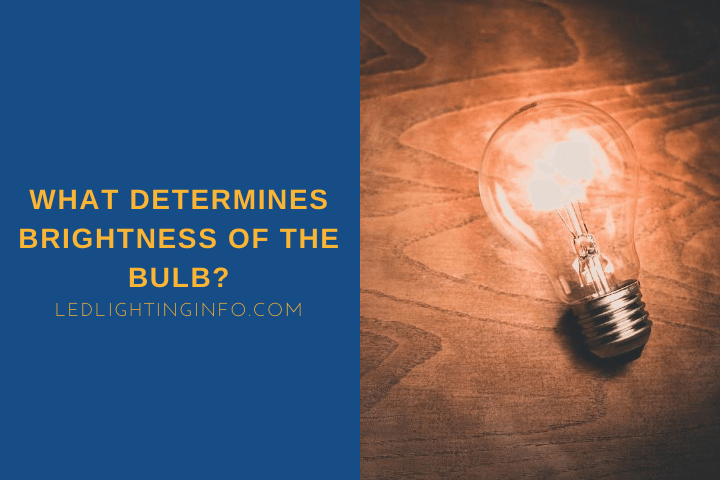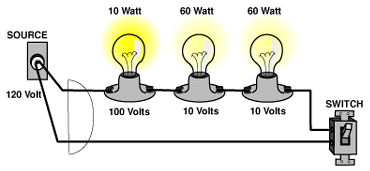Now if for example a tiny wire was being used then it would cause a resistance and the more current drawn the mre voltage drop on the wire so yes the bulb would dim. For lower current the resistance is lower.

Which Bulb Glows Brighter When Connected In Series Why
A higher voltage will cause more electrons to flow through the filament if the brightness is due to a flow of electrons through it.

. The resistance of the bulbs is the same. This condition usually occurs. Increasing the Voltage across the bulb 2.
If you connect a round bulb and a long bulb in parallel however it is the round bulb that is brighter because now the voltage across both bulbs is the same but the current is larger through the round bulb smaller resistance. So in practice as voltage doesnt vary then a brighter bulb has to use more current. The brightness is dependent on the current and resistance.
The brightness is dependent on the current and resistance. This heats up when an electric current passes through it and produces light as a result. The power of a light bulb has an effect on its brightness.
For a given efficiency then the brighter the bulb the more power it consumes. By increasing the current but not increasing the voltage or only a negligible amount and purely. The greater the current through the light bulb the brighter it glows.
The push that is the voltage. Lower pressure results in a lower flow rate. Brightness depends on current times voltage which equals the power used by the bulb.
Nothing will happen to change the brightness because the resistor is in parallel so both get the same voltage and as much current as required. The resistance of a lamp increases as the temperature of its filament increases. The higher the voltage v the higher the current.
Current and voltage leading to power. The same current may not be experienced by them. The flow that is the current.
55 5308 Views. 22 Votes A filament lamp is a common type of light bulb. When you are asked to rank the brightness of identical bulbs youre actually being asked to rank the amount of current through each one.
The brightness is the intensity or the power produced by the bulb. Hence the brightness of a bulb depends on power ie both voltage and current. So the brightness is a function of both current and voltage and can be said to depend on both.
By either including a resistor in the circuit to fill the gap between the supply voltage and the forward voltage limiting the current in the process or by using a constant current supply we can set the current that we want to flow through the LED and thus set the brightness. Likewise what determines the brightness of a light bulb current or voltage. For lower current the resistance is lower.
It is because the resistance of the light bulb changes with the temperature current see wikipedia. To predict the brightness of bulbs you need to think about the power in the electrical pathway. High voltage is like high pressure in the water flow examples--it causes a high flow rate.
Brightness can increased by increasing current flowing through the bulb but current can be increased only indirectly by 1. If the brightness is caused by a flow of electrons through the filament a higher voltage will--all things being equal-- drive more electrons to flow through the filament. What determines the brightness of a light bulb current or voltage.
Still you cant have a current without creating a voltage so for all real-world applications the brightness is caused by the power dissipated in the bulb. The power of a light bulb has an effect on its brightness. The higher the voltage v the higher the current.
The brightness is the result of two electrical factors. When considering standard household electricity it will likely be a 120V circuit. The current is higher if the voltage is higher.
The current is higher if the voltage is. The brightness depends on both the current and the voltage. The current flowing through a filament lamp is not directly proportional to the voltage across it.
Reducing the Resistance of. The bulb appears dim when the bulb has a low voltage and the available current is also limited. How do voltage and current relate to the brightness of a bulb.
Of course the usual situation is that voltage is constant fixed by the power supply. Ohms law says current equal voltage divided by resistance I VR. Use the slider to change the voltage of the battery and observe the effect on the current.
If you want to get really nerdy about it i guess it would be slightlymore correct to say that the brightness is caused by the current. If the brightness is caused by a flow of electrons through the filament a higher voltage will--all things being equal-- drive more electrons to flow through the filament. Therefore the current of two light bulbs is going to be less than the current of one light bulb but more than a half of one light bulb.
The same current may not be experienced by them.

What Determines The Brightness Of The Bulb Led Lighting Info

Does A Light Bulb S Brightness Depend On Voltage Or Current Explained In Tamil Youtube

0 Comments